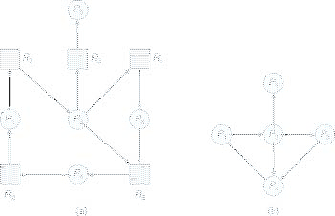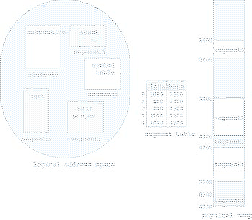- Mirroring provides high reliability, but it is expensive.
- Striping provides high data-transfer rates, but it does not improve reliability.
- Numerous schemes to provide redundancy at lower cost by using the idea of disk striping combined with ``parity'' bits have been proposed.
- These schemes have different cost-performance trade-offs and are classified according to levels called RAID levels (see Figs. 12.14);
Figure 12.14:
RAID levels.
|
|
(in the figure,  indicates error-correcting bits, and
indicates error-correcting bits, and  indicates a second copy of the data).
indicates a second copy of the data).
- In all cases depicted in the figure, four disks' worth of data are stored, and the extra disks are used to store redundant information for failure recovery.
- RAID Level O. RAID level 0 refers to disk arrays with striping at the level of blocks but without any redundancy (such as mirroring or parity bits).
- RAID Level 1. RAID level 1 refers to disk mirroring.
- RAID Level 2. RAID level 2 is also known as memory-style error-correcting-code (ECC) organization. Memory systems have long detected certain errors by using parity bits.
- RAID Level 3. RAID level 3, or bit-interleaved parity organization, improves on level 2 by taking into account the fact that, unlike memory systems, disk controllers can detect whether a sector has been read correctly, so a single parity bit can be used for error correction as well as for detection.
- RAID Level 4. RAID level 4, or block-interleaved parity organization, uses block-level striping, as in RAID 0, and in addition keeps a parity block on a separate disk for corresponding blocks from
 other disks.
other disks.
- RAID Level 5. RAID level 5, or block-interleaved distributed parity, differs from level 4 by spreading data and parity among all
 disks, rather than storing data in
disks, rather than storing data in  disks and parity in one disk. For each block, one of the disks stores the parity, and the others store data.
disks and parity in one disk. For each block, one of the disks stores the parity, and the others store data.
- RAID Level 6. RAID level 6, also called the
 redundancy scheme, is much like RAID level 5 but stores extra redundant information to guard against multiple disk failures.
redundancy scheme, is much like RAID level 5 but stores extra redundant information to guard against multiple disk failures.
- RAID Level 0 + 1. RAID level 0 + 1 refers to a combination of RAID levels 0 and 1. RAID 0 provides the performance, while RAID 1 provides the reliability. Generally, this level provides better performance than RAID 5. It is common in environments where both performance and reliability are important. Unfortunately, it doubles the number of disks needed for storage, as does RAID I, so it is also more expensive.
Cem Ozdogan
2010-05-25